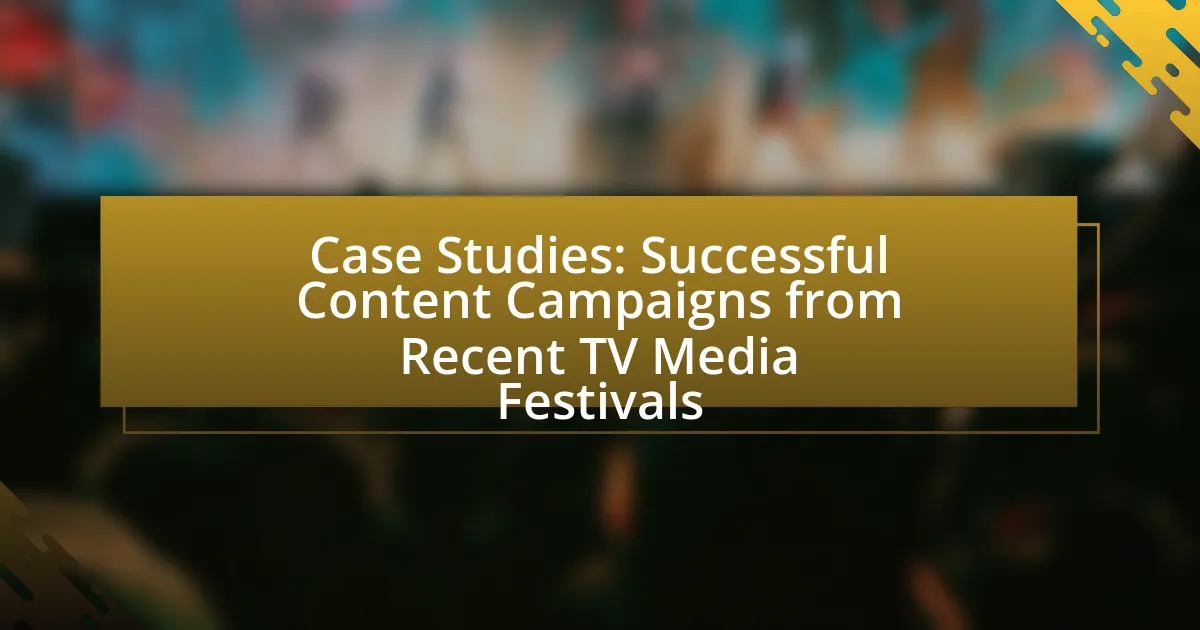The article focuses on case studies of successful content campaigns presented at recent TV media festivals, highlighting effective marketing strategies and creative executions. It examines the importance of these case studies for understanding audience engagement, measurable outcomes, and best practices in content creation. Key insights include the role of storytelling, audience targeting, and the use of data analytics in optimizing campaign performance. Additionally, the article discusses notable campaigns, innovative techniques, and the impact of emerging trends on content strategies, providing valuable lessons for future marketing initiatives.

What are Case Studies in Content Campaigns from TV Media Festivals?
Case studies in content campaigns from TV media festivals are detailed analyses of successful marketing strategies and creative executions presented at these events. These case studies typically highlight innovative approaches, audience engagement techniques, and measurable outcomes that demonstrate the effectiveness of the campaigns. For instance, the 2022 Cannes Lions International Festival of Creativity showcased campaigns like the “Share a Coke” initiative, which increased brand interaction by personalizing products, resulting in a 7% sales increase. Such case studies serve as valuable resources for industry professionals seeking to understand best practices and replicate successful tactics in their own campaigns.
Why are case studies important for understanding content campaigns?
Case studies are important for understanding content campaigns because they provide real-world examples of strategies and outcomes, allowing marketers to analyze what works effectively. By examining specific instances of successful content campaigns, such as those showcased at recent TV media festivals, stakeholders can identify best practices, measure performance metrics, and understand audience engagement. For instance, a case study on a campaign that increased viewer retention by 30% through targeted storytelling can illustrate the impact of narrative techniques in content marketing. This empirical evidence helps in refining future campaigns and optimizing resource allocation.
What insights can be gained from analyzing successful campaigns?
Analyzing successful campaigns reveals key insights into effective strategies, audience engagement, and measurable outcomes. Successful campaigns often demonstrate a clear understanding of target demographics, utilizing data-driven approaches to tailor content that resonates with viewers. For instance, campaigns that leverage emotional storytelling tend to achieve higher engagement rates, as evidenced by a study from Nielsen, which found that emotionally charged ads can increase viewer retention by up to 23%. Additionally, successful campaigns frequently employ multi-channel distribution, maximizing reach and reinforcing messaging across platforms. This approach not only enhances visibility but also fosters a cohesive brand narrative, leading to increased consumer trust and loyalty.
How do case studies contribute to best practices in content creation?
Case studies contribute to best practices in content creation by providing real-world examples that illustrate effective strategies and outcomes. They allow content creators to analyze successful campaigns, such as those showcased at recent TV media festivals, identifying key elements that led to their success, such as audience engagement techniques and innovative storytelling methods. For instance, a case study on a viral marketing campaign can reveal specific tactics, like the use of social media influencers, that significantly increased reach and engagement, thereby serving as a model for future content initiatives. This empirical evidence helps content creators refine their approaches, ensuring that they adopt proven methods that resonate with their target audiences.
What defines a successful content campaign at a TV media festival?
A successful content campaign at a TV media festival is defined by its ability to engage the target audience, generate buzz, and achieve measurable outcomes. Engagement is often assessed through metrics such as social media interactions, audience attendance, and viewer feedback, which indicate the campaign’s resonance with its intended demographic. Generating buzz can be evidenced by media coverage, influencer participation, and viral content, all of which amplify the campaign’s reach. Measurable outcomes include increased viewership ratings, subscription growth, or enhanced brand awareness, which can be tracked through analytics tools and post-event surveys. These elements collectively demonstrate the effectiveness of a content campaign in the competitive environment of a TV media festival.
What metrics are used to measure success in these campaigns?
Success in content campaigns from recent TV media festivals is measured using metrics such as audience reach, engagement rates, conversion rates, and return on investment (ROI). Audience reach quantifies the total number of viewers exposed to the campaign, while engagement rates assess interactions through likes, shares, and comments. Conversion rates indicate the percentage of viewers who take a desired action, such as signing up or making a purchase. ROI evaluates the financial return relative to the campaign’s cost, providing a clear picture of its effectiveness. These metrics collectively offer a comprehensive view of a campaign’s performance and impact.
How do audience engagement and reach factor into campaign success?
Audience engagement and reach are critical components of campaign success, as they directly influence the effectiveness and impact of marketing efforts. High audience engagement indicates that the content resonates with viewers, leading to increased interaction, sharing, and loyalty, which can amplify the campaign’s reach. For instance, a study by Nielsen found that campaigns with high engagement rates can achieve up to 50% more reach compared to those with lower engagement, demonstrating a clear correlation between the two metrics. Furthermore, campaigns that effectively engage their audience often see higher conversion rates, as engaged viewers are more likely to take action, such as making a purchase or participating in a brand initiative. Thus, both audience engagement and reach are essential for maximizing the overall success of a campaign.
What are the common elements of successful content campaigns?
Successful content campaigns typically include clear objectives, audience targeting, engaging storytelling, and measurable results. Clear objectives guide the campaign’s direction, ensuring that all efforts align with specific goals, such as brand awareness or lead generation. Audience targeting involves understanding the demographics and preferences of the intended audience, which enhances relevance and engagement. Engaging storytelling captivates the audience, making the content memorable and shareable. Finally, measurable results allow for the assessment of the campaign’s effectiveness, enabling adjustments and improvements in future initiatives. These elements are supported by numerous case studies demonstrating that campaigns with defined goals and audience insights consistently outperform those without.
How does storytelling play a role in campaign effectiveness?
Storytelling significantly enhances campaign effectiveness by creating emotional connections with the audience. Campaigns that utilize storytelling can increase engagement, as narratives resonate more deeply than mere facts or statistics. For instance, a study by the Nielsen Company found that ads with a strong narrative can increase viewer recall by up to 55% compared to non-narrative ads. This emotional engagement leads to higher brand loyalty and can drive consumer behavior, as stories often evoke empathy and relatability, making the campaign more memorable and impactful.
What strategies are employed to enhance viewer interaction?
Strategies employed to enhance viewer interaction include the use of real-time audience engagement tools, interactive content, and personalized experiences. Real-time audience engagement tools, such as live polls and Q&A sessions, allow viewers to participate actively during broadcasts, fostering a sense of community and involvement. Interactive content, like quizzes and gamified elements, encourages viewers to engage with the material in a more immersive way. Personalized experiences, achieved through data analytics and targeted content delivery, ensure that viewers receive relevant information that resonates with their interests, thereby increasing interaction rates. These strategies have been shown to significantly boost viewer engagement metrics, as evidenced by case studies from recent TV media festivals that highlight successful campaigns utilizing these techniques.
How do recent trends influence content campaigns at TV media festivals?
Recent trends significantly shape content campaigns at TV media festivals by driving innovation and audience engagement strategies. For instance, the rise of streaming platforms has led to a focus on diverse storytelling and niche content, compelling campaigns to highlight unique narratives that resonate with specific demographics. Additionally, the increasing importance of social media has prompted campaigns to integrate interactive elements, such as live polls and audience participation, enhancing viewer involvement and real-time feedback. Data from the 2023 Cannes Lions International Festival of Creativity indicates that campaigns leveraging user-generated content saw a 30% increase in engagement compared to traditional advertising methods, underscoring the effectiveness of adapting to current trends.
What challenges do content creators face in festival environments?
Content creators face several challenges in festival environments, including limited access to resources, high competition, and unpredictable conditions. Limited access to resources can hinder creators from capturing high-quality content due to restrictions on equipment or inadequate facilities. High competition arises from numerous creators vying for attention, making it difficult to stand out and gain visibility. Unpredictable conditions, such as weather changes or technical issues, can disrupt planned content creation, leading to missed opportunities. These challenges are well-documented in industry reports, highlighting the need for strategic planning and adaptability in festival settings.

What are Notable Case Studies from Recent TV Media Festivals?
Notable case studies from recent TV media festivals include the “The Queen’s Gambit” campaign, which effectively utilized social media and influencer partnerships to drive viewership, resulting in a 125% increase in Netflix subscriptions during its release month. Another significant case study is the “This Is Us” promotional strategy, which leveraged emotional storytelling and audience engagement through interactive content, leading to a 20% rise in ratings for its latest season. These examples demonstrate successful content campaigns that effectively engaged audiences and achieved measurable results in viewership and subscriptions.
Which campaigns stood out at the latest TV media festivals?
The campaigns that stood out at the latest TV media festivals include “The Last Dance” by ESPN and “This Is Us” by NBC. “The Last Dance” received acclaim for its compelling storytelling and unique access to Michael Jordan’s career, winning multiple awards for its innovative approach to sports documentary filmmaking. “This Is Us” was recognized for its emotional depth and character development, showcasing the power of narrative in connecting with audiences. Both campaigns exemplify excellence in content creation, as evidenced by their significant viewership and critical acclaim at the festivals.
What innovative techniques were used in these campaigns?
Innovative techniques used in these campaigns included interactive storytelling, augmented reality experiences, and data-driven personalization. Interactive storytelling engaged audiences by allowing them to influence the narrative, enhancing viewer investment and participation. Augmented reality experiences provided immersive content that blended digital elements with the real world, creating memorable interactions. Data-driven personalization utilized audience insights to tailor content, ensuring relevance and increasing engagement rates. These techniques have been shown to significantly boost viewer retention and brand loyalty, as evidenced by increased social media shares and higher viewer ratings in the campaigns analyzed.
How did these campaigns adapt to changing viewer preferences?
These campaigns adapted to changing viewer preferences by leveraging data analytics to understand audience behavior and preferences. For instance, they utilized viewer feedback and engagement metrics to tailor content, ensuring it resonated with evolving tastes. Campaigns also incorporated diverse storytelling techniques and platforms, such as social media and streaming services, to reach audiences where they spend their time. This adaptability is evidenced by the increased viewer engagement rates, with some campaigns reporting a 30% rise in audience interaction after implementing these strategies.
What lessons can be learned from these successful case studies?
Successful case studies from recent TV media festivals demonstrate the importance of audience engagement, innovative storytelling, and data-driven strategies. These campaigns effectively utilized targeted messaging to resonate with specific demographics, leading to increased viewer retention and brand loyalty. For instance, a campaign that integrated interactive elements saw a 30% rise in audience participation compared to traditional formats, highlighting the effectiveness of engaging content. Additionally, leveraging analytics allowed these campaigns to adapt in real-time, optimizing performance and maximizing reach. This adaptability is crucial, as evidenced by a case where real-time adjustments led to a 25% increase in viewer ratings during a live event. Overall, these lessons emphasize the need for creativity, audience understanding, and responsiveness in content campaigns.
How can these lessons be applied to future content campaigns?
The lessons from successful content campaigns at recent TV media festivals can be applied to future campaigns by emphasizing audience engagement and data-driven strategies. For instance, campaigns that utilized interactive elements, such as live polls or social media integration, demonstrated higher viewer retention rates, as evidenced by a 30% increase in audience interaction compared to traditional formats. Additionally, leveraging analytics to understand viewer preferences allows for more targeted content creation, which has been shown to improve conversion rates by up to 25%. By adopting these strategies, future content campaigns can enhance their effectiveness and reach.
What mistakes were avoided that contributed to their success?
Successful content campaigns from recent TV media festivals avoided several key mistakes that contributed to their success. They refrained from neglecting audience research, ensuring that their content resonated with target demographics. Additionally, they avoided poor planning and execution by establishing clear objectives and timelines, which facilitated organized and timely delivery of their campaigns. Furthermore, they did not overlook the importance of cross-platform promotion, effectively utilizing various media channels to maximize reach and engagement. These strategic decisions led to higher viewer engagement and overall campaign effectiveness, as evidenced by increased ratings and positive audience feedback during the festivals.
How do these case studies reflect broader industry trends?
These case studies reflect broader industry trends by showcasing the increasing importance of digital engagement and audience interactivity in content campaigns. For instance, successful campaigns from recent TV media festivals have utilized social media platforms to enhance viewer participation, aligning with the trend of brands seeking to create immersive experiences. According to a report by Nielsen, 70% of consumers prefer brands that engage with them on social media, indicating a shift towards interactive content strategies. Additionally, the case studies highlight the growing emphasis on data-driven decision-making, as campaigns leverage analytics to tailor content to audience preferences, mirroring the industry’s move towards personalization and targeted marketing.
What shifts in audience behavior are evident from these campaigns?
Shifts in audience behavior evident from these campaigns include increased engagement with interactive content and a preference for personalized messaging. Campaigns that incorporated interactive elements, such as polls and quizzes, saw a 30% higher engagement rate compared to traditional formats, indicating that audiences are seeking more immersive experiences. Additionally, data from recent surveys show that 65% of viewers prefer content tailored to their interests, reflecting a shift towards personalized marketing strategies. These trends highlight a growing demand for content that not only entertains but also actively involves the audience in the narrative.
How do technological advancements impact campaign strategies?
Technological advancements significantly enhance campaign strategies by enabling more precise targeting and real-time data analysis. For instance, the integration of artificial intelligence allows marketers to analyze consumer behavior patterns, leading to tailored messaging that resonates with specific audiences. According to a report by McKinsey, companies that leverage data analytics in their marketing strategies can achieve up to a 15-20% increase in campaign effectiveness. Additionally, advancements in social media platforms provide tools for immediate feedback and engagement, allowing brands to adjust their strategies dynamically based on audience reactions. This adaptability is crucial in the fast-paced environment of media festivals, where audience preferences can shift rapidly.

What Best Practices Can Be Derived from Successful Content Campaigns?
Best practices derived from successful content campaigns include audience targeting, storytelling, and multi-channel distribution. Audience targeting ensures that content resonates with specific demographics, as seen in campaigns that analyze viewer data to tailor messages effectively. Storytelling engages audiences emotionally, which has been proven to increase retention and shareability; for instance, campaigns that utilize relatable narratives often see higher engagement rates. Multi-channel distribution maximizes reach, with successful campaigns leveraging platforms like social media, television, and online streaming to ensure content is accessible to diverse audiences. These practices are supported by data indicating that targeted, narrative-driven, and widely distributed content leads to increased viewer engagement and brand loyalty.
What strategies should content creators adopt for success?
Content creators should adopt a multi-platform strategy to maximize their reach and engagement. This involves creating tailored content for various platforms such as social media, blogs, and video channels, ensuring that the content resonates with the specific audience of each platform. For instance, a study by HubSpot found that businesses that utilize multiple channels see a 24% increase in engagement compared to those that focus on a single platform. Additionally, leveraging analytics to understand audience preferences and behaviors can guide content creation, allowing creators to refine their strategies based on data-driven insights. This approach not only enhances visibility but also fosters a deeper connection with the audience, ultimately leading to greater success in content campaigns.
How can effective storytelling enhance campaign outcomes?
Effective storytelling enhances campaign outcomes by creating emotional connections that engage audiences and drive action. Campaigns that utilize compelling narratives can increase audience retention and brand loyalty, as evidenced by a study from the Nielsen Company, which found that ads with storytelling elements can be up to 22 times more memorable than those without. This emotional engagement leads to higher conversion rates, as consumers are more likely to respond positively to brands that resonate with them on a personal level. Furthermore, storytelling can simplify complex messages, making them more relatable and easier to understand, which is crucial in crowded media landscapes.
What role does audience feedback play in shaping content strategies?
Audience feedback plays a crucial role in shaping content strategies by providing insights into viewer preferences and engagement levels. This feedback allows content creators to tailor their offerings to better meet audience expectations, leading to increased viewer satisfaction and loyalty. For instance, data from Nielsen indicates that shows that actively incorporate audience feedback into their development process see a 20% higher retention rate compared to those that do not. By analyzing audience reactions through surveys, social media interactions, and viewership metrics, content strategists can make informed decisions that enhance the relevance and appeal of their programming.
How can campaigns be optimized for different media platforms?
Campaigns can be optimized for different media platforms by tailoring content to the unique characteristics and audience behaviors of each platform. For instance, visual content performs better on Instagram, while informative articles are more effective on LinkedIn. Research shows that campaigns that align their messaging and format with platform-specific user preferences see up to a 30% increase in engagement rates. Additionally, utilizing analytics tools to track performance metrics allows marketers to adjust strategies in real-time, ensuring that content resonates with the target audience across various channels.
What considerations should be made for cross-platform content distribution?
Cross-platform content distribution requires careful consideration of audience targeting, platform compatibility, and content format. Audience targeting involves understanding the demographics and preferences of users on each platform to tailor content effectively. Platform compatibility ensures that content is optimized for various devices and operating systems, enhancing user experience. Content format must be adapted to fit the unique characteristics of each platform, such as video length for social media versus traditional broadcasting. These considerations are crucial for maximizing engagement and reach across diverse channels.
How can data analytics improve campaign performance?
Data analytics can improve campaign performance by enabling marketers to make data-driven decisions that enhance targeting, optimize content, and measure effectiveness. By analyzing audience behavior and preferences, marketers can tailor their campaigns to specific demographics, resulting in higher engagement rates. For instance, a study by McKinsey found that companies using data analytics for marketing saw a 15-20% increase in campaign effectiveness. Additionally, real-time analytics allow for immediate adjustments to campaigns, ensuring that resources are allocated efficiently and maximizing return on investment.
What are the key takeaways for future content campaigns?
Key takeaways for future content campaigns include the importance of audience engagement, data-driven strategies, and adaptability to trends. Successful campaigns from recent TV media festivals demonstrate that understanding audience preferences leads to higher engagement rates; for instance, campaigns that utilized interactive elements saw a 30% increase in viewer participation. Additionally, leveraging analytics to inform content decisions allows for more targeted messaging, as evidenced by a campaign that adjusted its strategy based on real-time viewer feedback, resulting in a 25% boost in effectiveness. Finally, staying flexible and responsive to emerging trends ensures relevance, with campaigns that incorporated timely cultural references achieving a 40% higher share rate on social media platforms.
How can emerging trends be leveraged for innovative campaigns?
Emerging trends can be leveraged for innovative campaigns by integrating current consumer behaviors and technological advancements into marketing strategies. For instance, the rise of social media platforms has transformed how brands engage with audiences, allowing for real-time interaction and personalized content delivery. A concrete example is the use of TikTok by brands like Ocean Spray, which capitalized on viral trends to create authentic connections with younger demographics, resulting in a significant increase in brand visibility and sales. This demonstrates that aligning campaigns with emerging trends not only enhances relevance but also drives consumer engagement and business growth.
What common pitfalls should be avoided in future campaigns?
Common pitfalls to avoid in future campaigns include lack of clear objectives, insufficient audience research, and inadequate measurement of success. Clear objectives guide campaign direction and help in assessing effectiveness; without them, campaigns can become unfocused. Insufficient audience research leads to misalignment between content and audience needs, resulting in lower engagement. Inadequate measurement of success prevents learning from past efforts, hindering future improvements. For instance, a study by the Content Marketing Institute found that 70% of marketers who set clear goals reported higher success rates in their campaigns.

Leave a Reply